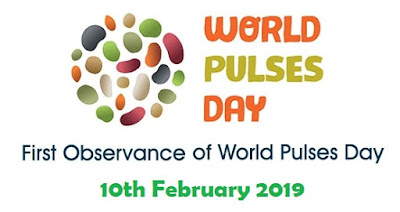World Pulses Day 2019
World Pulses Day 10 February 2019
உலக பருப்பு வகைகள் தினம் - பிப்ரவரி 10
International Year of Pulses 2016
- Recognizing all its values, in 2013 the General Assembly declared in its resolution 68/231 the International Year of Pulses 2016, which raised the role of pulses in contributing to sustainable food production aimed towards food security and nutrition.
10 February World Pulses Day
- In 2018, the UN General Assembly decided that 10 February will mark World Pulses Day, keeping alive the positive momentum surrounding these healthy, nutritious, protein-rich, nitrogen-fixing legumes after FAO's successful 2016 International Year of Pulses Campaign.
 |
| World Pulses Day 10 February |
What are Pulses?
- Pulses are a type of leguminous crop that are harvested solely for the dry seed. Dried beans, lentils and peas are the most commonly known and consumed types of pulses.
- Pulses do not include crops that are harvested green (e.g. green peas, green beans)—these are classified as vegetable crops.
- Also excluded are those crops used mainly for oil extraction (e.g. soybean and groundnuts) and leguminous crops that are used exclusively for sowing purposes (e.g. seeds of clover and alfalfa).
- Pulses include all varieties of dried beans, such as kidney beans, lima beans, butter beans and broad beans. Chick peas, cowpeas, black-eyed peas and pigeon peas are also pulses, as are all varieties of lentils.
- Staples dishes and cuisines from across the world feature pulses, from hummus in the Mediterranean (chick peas), to a traditional full English breakfast (baked navy beans) to Indian dal (peas or lentils).
Why are pulses important crops?
Nutritional value
- Pulses are essential crops for a number of reasons.
- They are packed with nutrients and have a high protein content, making them an ideal source of protein particularly in regions where meat and dairy are not physically or economically accessible.
- Pulses are low in fat and rich in soluble fibre, which can lower cholesterol and help in the control of blood sugar.
- Because of these qualities they are recommended by health organizations for the management of non-communicable diseases like diabetes and heart conditions. Pulses have also been shown to help combat obesity.
Food security
- For farmers, pulses are an important crop because they can be both sold and consumed by the farmers and their families.
- Having the option to eat and sell the pulses they grow helps farmers maintain household food security and creates economic stability.
- Furthermore, the nitrogen-fixing properties of pulses improve soil fertility, which increases and extends the productivity of the farmland.
- By using pulses for intercropping and cover crops, farmers can also promote farm biodiversity and soil biodiversity, while keeping harmful pests and diseases at bay.
Climate change mitigation
- Pulses can contribute to climate change mitigation by reducing dependence on the synthetic fertilizers used to introduce nitrogen artificially into the soil.
- Greenhouse gases are released during the manufacturing and application of these fertilizers, and their overuse can be detrimental to the environment.
- However, pulses fix atmospheric nitrogen in the soil naturally, and in some cases free soil-bound phosphorous, thus significantly decreasing the need for synthetic fertilizers.
Sources: https://www.un.org